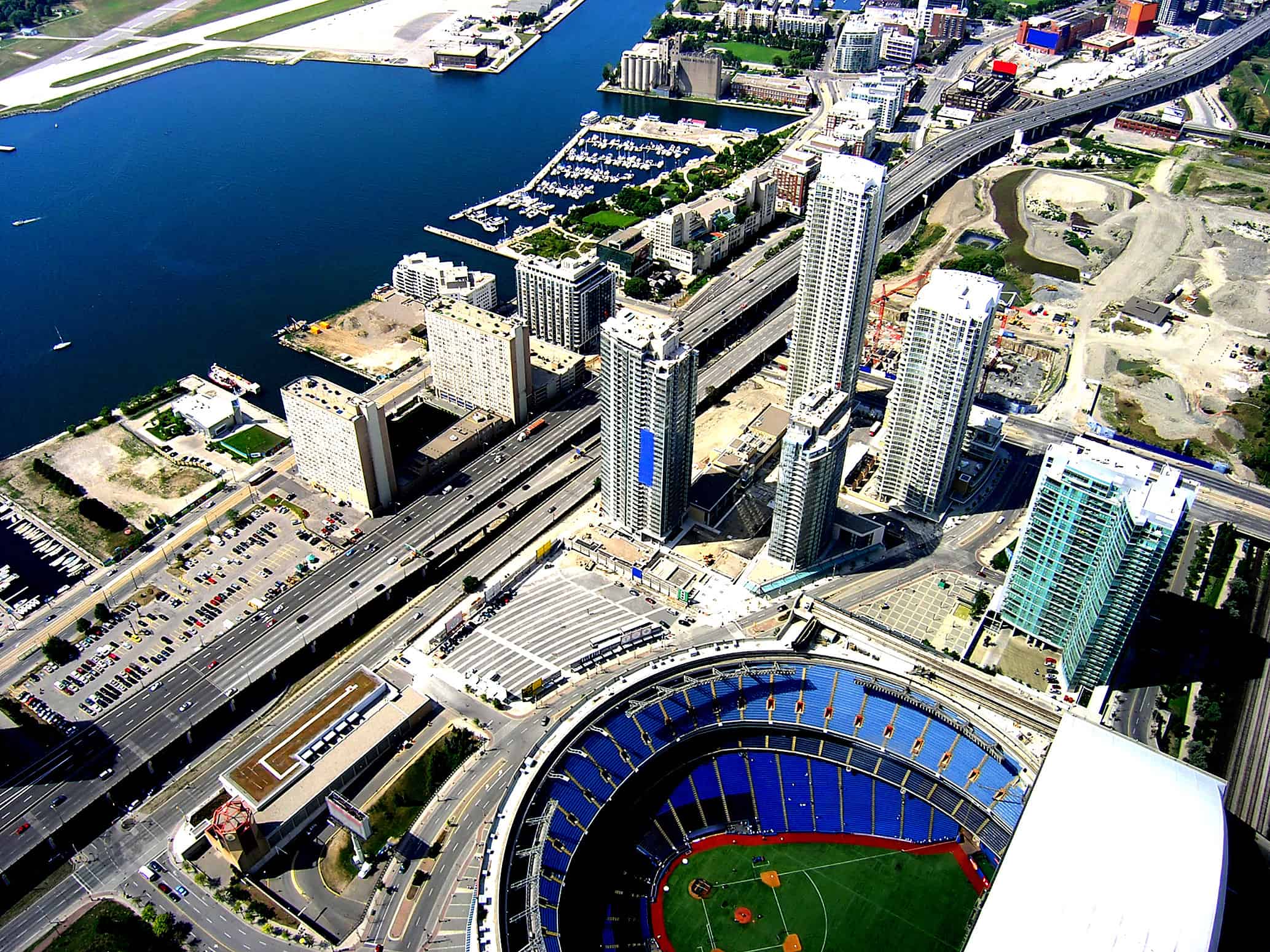It’s time to embark on a journey through the largest city in Canada and discover its extraordinary charm. But first, let’s dig into some information about Canada that we can correlate to its largest city.
Canada: An Overview
History of Canada
Christopher Columbus discovered North America in 1492, launching the Age of Exploration (1500s-1800s). European empires, including Spain, Portugal, France, the Netherlands, and Britain, sent expeditions to North America to settle and expand their empires.
In the early 16th century, nearly 16,000 French people landed in North America. They settled as subsistence farmers along the St. Lawrence River, colonizing lands that Spain had not yet claimed.
Britain was the last of the major European powers to arrive in North America, nearly a century after Spain. They struggled to establish settlements but eventually succeeded in establishing Jamestown, Virginia, in 1607.
French and Indian War
North America, a beautiful land with endless opportunities and resources, attracted European settlers in the early 16th and 17th centuries. The French occupied Canada, while the British held 13 colonies on the East Coast, looking to expand westward. The French also aimed to expand into the South. The Ohio River Valley became a hotspot and a point of conflict due to its trading importance and access to the Mississippi River.
These disputes against France introduced a young lieutenant general, George Washington, in 1754. He was tasked with defending a British fort, now Pittsburgh, and engaged the French troops, sparking the French and Indian War. Years of territorial disputes erupted into full-scale war in 1756. Both the British and the French sought support from local Native American tribes. Initially, the French had the upper hand, pushing the British back to their 13 colonies.
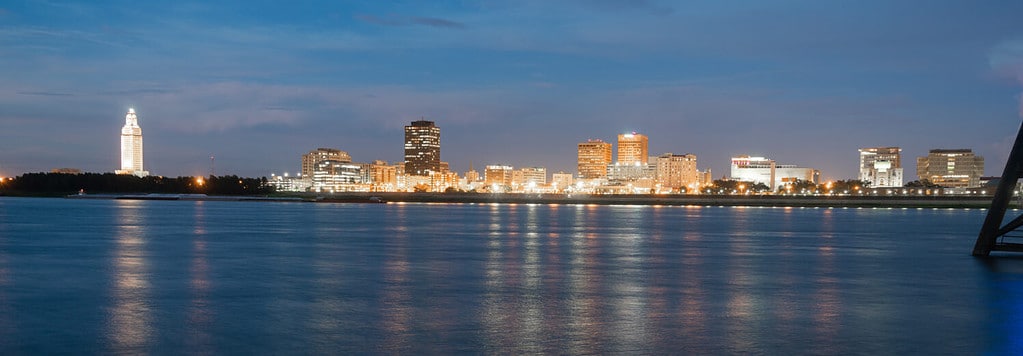
Night Falls on the Mississippi River.
©Real Window Creative/Shutterstock.com
Britain’s Triumph Over the French
The tide turned in 1757 when British Secretary of State William Pitt took charge. He provided funding and deployed more troops to the battlefield. The war ended with the British winning the Battle of Quebec and signing the Treaty of Paris in 1763.
Britain gained control of Canada and land east of the Mississippi River. However, the cost of the war led to taxation and protests in the American colonies, eventually resulting in American independence.
The Seven Years’ War raged from 1756 to 1763. Despite its name, the Seven Years’ War spanned across five continents. Winston Churchill dubbed it the First World War.
In Europe, Frederick the Great of Prussia confronted forces from Austria, Sweden, Russia, and France, igniting a protracted war. In 1763, two treaties emerged: the Treaty of Paris and the Treaty of Hubertusburg. The Treaty of Paris favored Britain, expanding its empire into upper North America (now Canada) while retaining French Quebec. The Treaty of Hubertusburg solidified Prussia’s influence in Europe.
Establishment of Two Jurisdictions
By 1791, Canada achieved official status through the establishment of two jurisdictions: Upper Canada and Lower Canada, encompassing the southern parts of present-day Quebec and Ontario. In 1841, they merged to form the Province of Canada, comprising Canada West and Canada East.
In 1860, 30 suggestions were made to name the United Federation of Canada, New Brunswick, and Nova Scotia. During this process, Acadia, Borealia, Cabotia, Hochelaga, Mesapelagia, Tuponia, and Transatlantica were mentioned.
On July 1, 1867, Father of Confederation Thomas D’Arcy McGee finalized the union of the three territories of Canada, Nova Scotia, and New Brunswick into a single dominion called the Dominion of Canada, as per the British North America Act.
Britain, Spain, and France all played significant roles in the formation of Canada. In 1867, Britain formed the Dominion of Canada from the colonies of New Brunswick, Nova Scotia, and the Province of Canada.
Etymology of Canada
French explorer Jacques Cartier’s Aboriginal companions, Taignoagny and Domagaya, directed him towards the Grande Rivière de Hochelaga (also known as the Rivière de Canada) in 1535, saying, That’s the way to Canada! By September 7, they were within 100 kilometers of Stadacona, now Quebec City.
Stadacona, a settlement along the St. Lawrence River, was home to Donacona, the chief of the Iroquoian-speaking tribe who met Cartier near the present-day town of Gaspé. Donacona’s sons had reportedly accompanied Cartier to France from Gaspé the previous year, and upon their return to Île d’Anticosti Island, they informed him that the Chemin de Canada (Route to Canada) lay beyond.
Because Cartier already knew Donacona, he learned from him that the area where Stadacona is located was also called Canada. In his 1535-6 Voyage report, he mentioned a list of words, including Kanata. This word means a cluster of dwellings or the lands ruled by Donnacona, a series of towns.
André Thevet, a contemporary French explorer, noted in his Voyage reports that the word Canada meant land. In several Iroquoian languages, the words for town or village conveyed the same idea. For instance, the Mohawk term is nekantaa, the Onondaga term is ganataje, and the Seneca term is iennekanandaa. Consequently, the origin and meaning of Canada seem unquestionable.
In the mid-1540s, French maps depicted the region north of Ile d’Anticosti as Canada. Maps from the 1550s displayed Canada on both sides, which later became Grande Riviere du Canada.
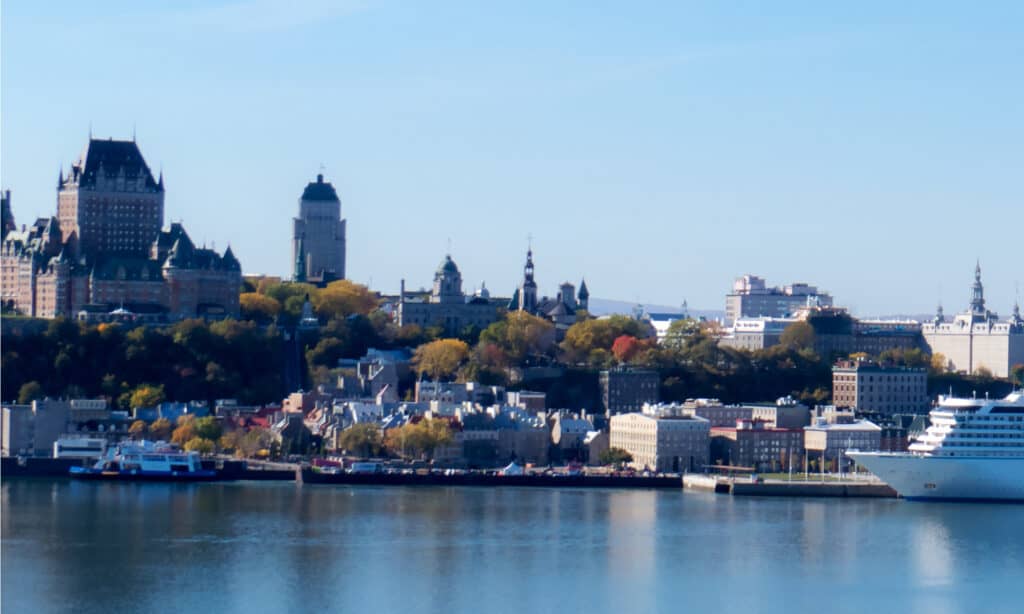
The Saint Lawrence River flows alongside Quebec City, a significant urban center situated on its banks.
©bulbspark/Shutterstock.com
Speculations
In 1698, Father Louis Hennepin reported that early Spanish explorers arriving in North America, finding no gold or riches, derisively exclaimed aca nada, meaning here nothing. By 1744, this phrase aca nada had been passed from Native peoples to Jacques Cartier, who may have associated it with Canada.
A second theory suggests that in 1760, Thomas Jeffreys, a British mapmaker, proposed that the name Canada may have originated from the Native language. It could mean Mouth of the Country, referring to the Mouth of the St. Lawrence River.
A writer from the Nova Scotia magazine in 1779 introduced the third theory, stating that a Frenchman named Cane once tried to establish a colony but failed, leaving his name associated with the territory.
The fourth theory, dating to 1811, claims that early French settlers asked for a Can a day of spruce beer from the colonial administrator, the Intendant, giving rise to the name Canada.
The Dictionary of Canadianism (1967) acknowledges that the etymology of Canada remains unclear, casting respect on the many imaginative suggestions that have emerged since Jacques Cartier’s time in the 16th century.

The renowned Rocher Percé rock in Quebec’s Gaspe Peninsula, Canada, during a serene blue sunrise with the sun’s path.
©Kristi Blokhin/Shutterstock.com
Geography of Canada
Canada boasts the world’s second-largest land area, featuring vast and rugged terrain, second only to Russia in size. It covers about 3,855,100 square miles (9,984,670 square kilometers) and extends from the Atlantic Ocean in the East, along the Arctic Ocean in the North, to the Pacific Ocean in the West. North to South, it spans over half of the Northern Hemisphere. Notably, Canada possesses the world’s longest coastline, measuring approximately 151,019 miles or 243,042 kilometers in length.
Moreover, Canada shares the world’s largest land border with the United States of America, extending over 5,525 miles or 8,891 kilometers. Additionally, Canada shares a land border with Greenland to the Northeast, with Hans Island forming a significant part of that boundary.
Canada is renowned for its abundant water resources, with over 2,000,000 lakes, including beautiful black-blue lakes and a vast network of rivers.
From the eastern Atlantic shores to the western Pacific coast, Canada spans six different time zones.
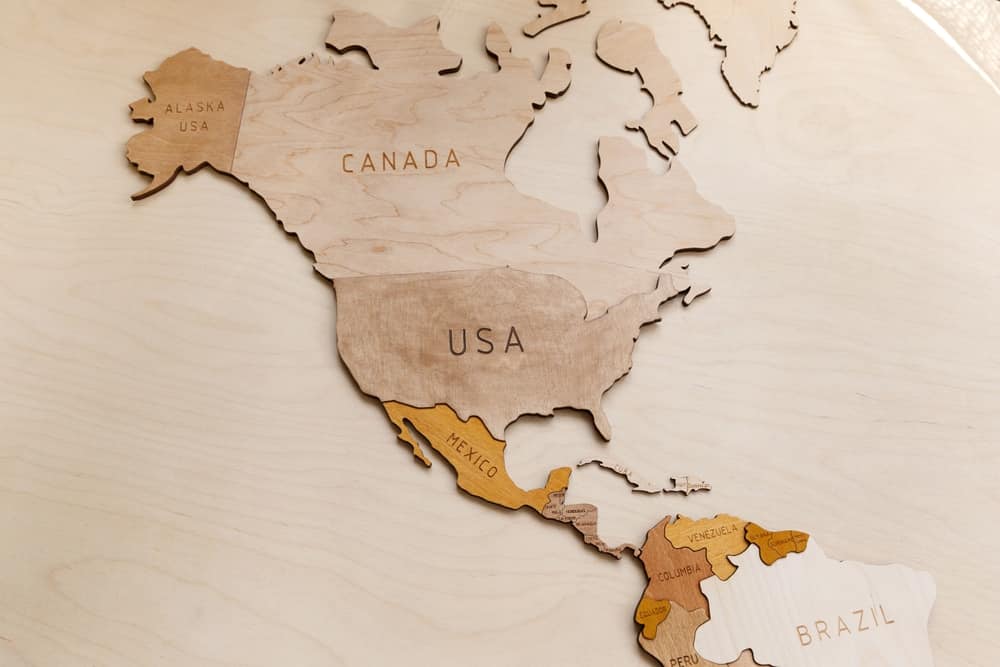
Canada shares the world’s largest land border with the United States of America.
©Olena Ilchenko/Shutterstock.com
The Largest City in Canada: Toronto
Toronto, Canada’s largest city and Ontario’s capital, stands as a global hub for business, finance, arts, sports, and culture. Renowned for its multicultural and cosmopolitan nature, it hosts a population exceeding 2.7 million, hailing from over 200 nations.
The Toronto Stock Exchange, North America’s third-largest, and the city’s strong presence in banking and finance underline its economic significance. Toronto’s technological innovation scene thrives, encompassing startups and Fortune 500 companies.
Tourism flourishes in Toronto, attracting visitors with its rich culture, diverse attractions, and world-class dining options. The city houses numerous museums and art galleries, including notable institutions like the Royal Ontario Museum, the Art Gallery of Ontario, and the Museum of Contemporary Art. The Toronto Zoo is the largest zoo in Canada.
A sporting giant, Toronto is home to the NHL’s Toronto Maple Leafs, the NBA’s Toronto Raptors, the MLB’s Toronto Blue Jays, and MLS’s Toronto FC. It has also hosted prestigious events, including the Pan American Games, the G20 summit, and the FIFA World Cup.
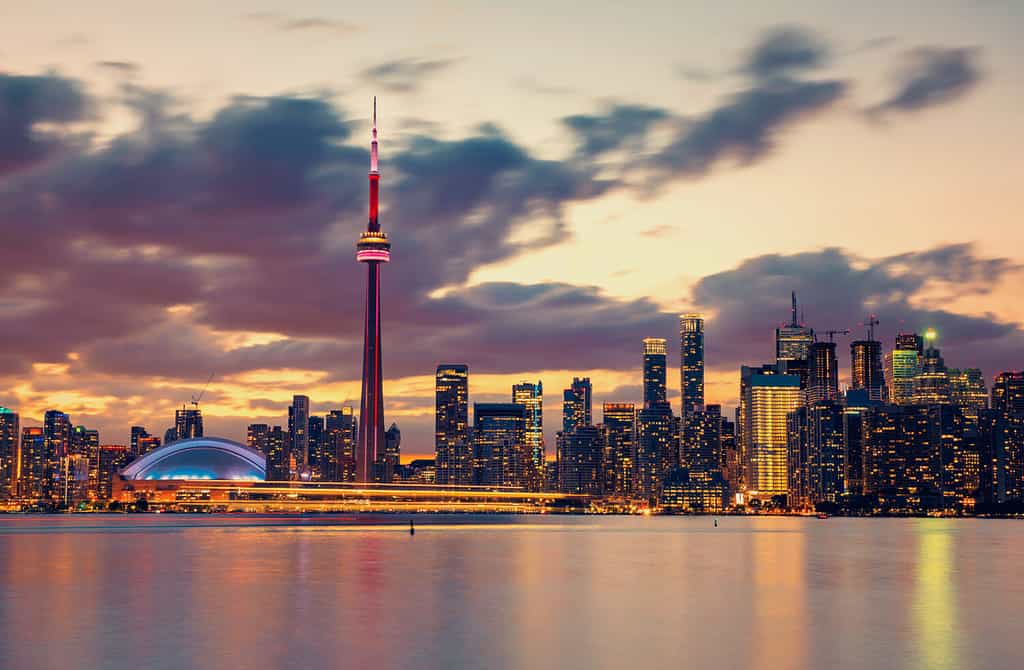
Stunning nighttime panorama of Toronto’s city skyline overlooking Lake Ontario in Canada.
©TRphotos/Shutterstock.com
Etymology of Toronto
The term Toronto, referring to The Narrows, denotes a water channel connecting Lake Simcoe to Lake Couchiching. Here, members of the Huron people, a member of the Confederation of Native North American People, planted tree saplings to corral fish.
In 1615, Samuel de Champlain, a multifaceted French explorer, navigator, soldier, cartographer, and geographer, documented that the Mohawk Tribe, an Iroquoian-speaking Indigenous people of North America, used the term tkaronto to describe The Narrows.
Moreover, the word Toronto, signifying plenty, was notably present in a 1632 French lexicon of the Huron Language, an Iroquoian language. Beyond these instances, multiple speculations continue to circulate regarding the etymology of the word Toronto.
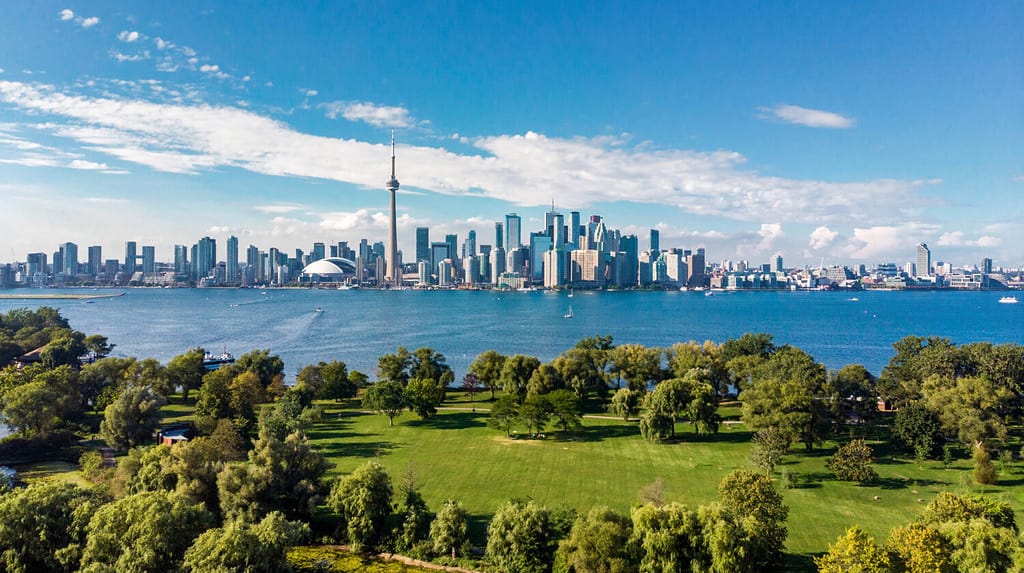
Toronto skyline and Lake Ontario aerial view, Toronto, Ontario, Canada.
©R.M. Nunes/Shutterstock.com
Greater Toronto Area
The Greater Toronto Area, often abbreviated as GTA, is a substantial region in southern Ontario encompassing several distinct areas. Its territorial expanse commences in Burlington within the Halton Region, running along Lake Ontario and extending past downtown Toronto. It further stretches eastward to Clarington, situated in the Durham region. The GTA comprises both the City of Toronto and several regional municipalities: Durham, Halton, Peel, and York. Within this extensive area, a diverse array of urban, suburban, and rural municipalities thrives, totaling 25 in all.
Moreover, the GTA collaborates with the City of Hamilton to form a Conurbation recognized as the Greater Toronto Area (GTA) and Hamilton Area. This amalgamation contributes to the development of the core of the Golden Horseshoe, strengthening the ties between the GTHA and the Niagara Region.

An Arriving Aircraft at GTA, Toronto Pearson International Airport.
©iStock.com/RITA
Toponymics of GTA
In the early 1900s, the term Greater Toronto Area referred only in writing to the Old City of Toronto and its immediate villages and townships. As time passed, in 1954, the Old City of Toronto and its immediate villages and townships grew and merged, forming what was known as Metropolitan Toronto. By 1998, this amalgamation was incorporated as the City of Toronto.
The term GTA, which encompasses the City of Toronto and its surrounding municipalities, was informally used until the mid-1980s but was officially recognized in the late 1990s. This reflected the ongoing expansion and unification of the region’s urban and suburban areas.

A bird’s-eye view of the urban landscape of Hamilton, Greater Toronto Area, and Hamilton, Ontario.
©Wirestock Creators/Shutterstock.com
Toronto’s Outlook for 2023
According to the 2021 census, the Municipality of Toronto, the largest in Canada, boasted a population of nearly 2.8 million people. East Gwillimbury, located on the outskirts of the Toronto Census Metropolitan Areas (CMA), emerged as the fastest-growing municipality with over 5,000 residents, signifying the expanding urbanization of the Toronto Area.
Population size and growth serve as crucial indicators, guiding municipal policymakers and administrators in planning essential services and infrastructure for their communities. These services encompass emergency response, education, healthcare, transportation, social welfare, and recreational spaces. The Census excels in furnishing accurate community-level data.
Municipalities in Canada, also known as Census Subdivisions, play a pivotal role in the country’s demographic landscape. Among these subdivisions, three suburban areas around Toronto stand out for having the 25 highest population growth rates nationwide. New Tecumseth boasts an impressive growth rate of 28.3%, followed by Bradford West Gwillimbury at 21.4% and Milton at 20.7%. Notably, these suburban areas have recorded growth rates more than four times higher than the Toronto Census Metropolitan Area (CMA) as a whole, where the overall growth rate is approximately 4.6%. This data showcases the rapid urban expansion and increasing residential appeal of these suburban regions.

Pedestrians crossing the streets in downtown Toronto.
©William Perugini/Shutterstock.com
Fun Facts
During 2021, urban expansion remained a dominant trend in Canada’s metropolitan regions, with suburban cities experiencing remarkable population growth, surpassing the rates observed in other areas.
These large urban regions, characterized by a population of at least 100,000 residents, often encompass multiple municipalities. For instance, the Census Metropolitan Area (CMA) of Toronto, located in Ontario, is a prime example. In addition to the city of Toronto itself, this CMA includes several municipalities, such as Mississauga, Brampton, Markham, Vaughan, and Richmond Hill. This extensive network of municipalities reflects the collaborative and interconnected nature of these urban hubs.
2023 Financial Outlook
On March 7, 2023, the City Manager, along with the Chief Financial Officer and Treasurer of Toronto, shed light on the significant financial challenges that the city is currently grappling with. These challenges have left their mark on the 2023 operating and capital budgets. It’s worth noting that 2023 marks the fourth year since the onset of COVID-19, and the financial impacts from increased costs to revenue losses continue to reverberate.
Much like other cities across the globe, Toronto is going through rough times marked by surging inflation, leading to cost escalations and broader economic implications. Rising interest rates have added to the city’s financial burden by increasing borrowing costs. Global disruptions in the supply chain and shortages in specialized labor further compound these challenges. Moreover, the city faces mounting pressure to meet the growing demand for services while adapting to unforeseen legislative changes, making budget development a daunting task.
Looking forward to 2023, Toronto anticipates that budget development will remain a demanding exercise due to increasing fiscal risks in both operating and capital areas.
Universities in Toronto as of 2023
Established in 1827, the University of Toronto holds the distinction of being Canada’s premier academic institution. Throughout its illustrious history, the university has consistently defied the limits and reshaped society through the innovation and determination of its faculty, students, and patrons.
Toronto provides a compelling combination of campus-based education and the advantages of metropolitan living. Students from various fields can pursue their studies here. Toronto is home to numerous prestigious universities, and tuition fees and living expenses are often on par with or even lower than those in the United States. Notable institutions like the University of Toronto, York University, and Toronto Metropolitan University draw students from across the globe.

University of Toronto, Victoria College, colorful fall ivy.
©Spiroview Inc/Shutterstock.com
Summing Up the Overall Growth of Toronto in 2023
As per the Ontario Chamber of Commerce, Ontario’s real GDP is predicted to decline by 0.4 percent due to persistent macroeconomic challenges. This includes geopolitical instability, labor shortages, and inflation. The forecasted employment growth is expected to slow down to 0.5 percent. It’s worth noting that all regions of Ontario experienced moderate-to-strong growth in both population and employment in 2022, and this growth trend is anticipated to continue in 2023. Here, Toronto significantly contributes to the majority of Ontario’s GDP.
Toronto’s Outlook for 2050
Population Growth
According to data from the Ontario Chamber of Commerce, Ontario Tech University, Canadian government statistics, and Census data, it is possible that Toronto will remain the largest city in 2050, continuing to attract immigrants from around the world. Toronto’s universities are consistently highly ranked and draw students globally. Projections indicate that by 2050, Toronto’s city population could reach 7,038,547 people. Economic conditions may improve if inflation is managed, leading to a stronger GDP compared to 2023. Employment opportunities might also see improvements in this scenario.
Climate Change Impact
Climatic changes are expected to significantly impact Toronto by 2050, making it one of the world’s most affected cities. According to experts, the city could witness a temperature rise ranging from 3.02 to 11.43 degrees Celsius, leading to more frequent and intense heat waves, with peak temperatures reaching 38.4 degrees Celsius. All of these scenarios are attributed to climatic change, with severe consequences if proactive measures aren’t implemented. However, the situation could improve if the Canadian government takes proactive steps to address the effects of climatic change. The combined effects of climatic change and shifting demographics might result in water shortage levels, leading to increased water stress.
Transit and Infrastructure
Municipalities and administrative authorities stress the importance of addressing transit and infrastructure needs to accommodate the city’s rapid growth. By 2050, the city’s transit networks could undergo significant transformations, implementing more efficient and sustainable options.
Suburban Growth
By 2050 or by 2066, The downtowns of Mississauga, Scarborough, and other suburban areas could become as dense as Toronto’s downtown is today, leading to accelerated suburban growth.
Future Challenges
As the City continues to expand, it will require smaller-scale solutions to match the rapid population growth. Toronto must increase investment in public education, from elementary schools to universities, to accommodate its growing and diverse population. Additionally, the city must confront challenges related to aging infrastructure and develop more sustainable and resilient systems to mitigate the impact of climate change.
Conclusion
In summary, Toronto is projected to undergo significant changes by 2050. The city will grow in size and density, becoming more diverse in both its core and suburban areas. Regarding demographics, Toronto is anticipated to become even more diverse by 2050. The city’s racialized population is set to see substantial growth, with projections indicating that 8 out of 10 Torontonians will be foreign-born or born to immigrant parents. The South Asian group, in particular, is expected to make up over 35% of Toronto’s total racialized population.
| CENSUS REGION | MUNICIPALITY | IN GTA? |
|---|---|---|
| Toronto | Yes | |
| Durham Region | Ajax Clarington Brock Oshawa Pickering Scugog Uxbridge Whitby | Yes |
| Halton Region | Burlington Halton Hills Milton Oakville | Yes |
| Peel Region | Brampton Caledon Mississauga | Yes |
| York Region | Aurora East Gwillimbury Georgina King Markham Newmarket Richmond Hill Vaughan Whitchurch-Stouffville | Yes |
| Dufferin County | Mono Orangeville | No |
| Simcoe County | Bradford West Gwillimbury New Tecumseth | No |
Thank you for reading! Have some feedback for us? Contact the AZ Animals editorial team.

